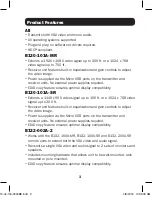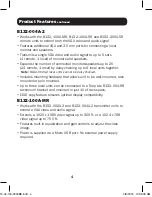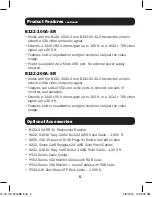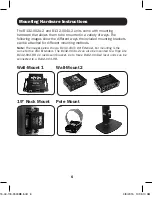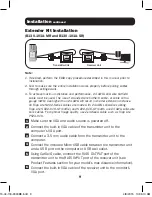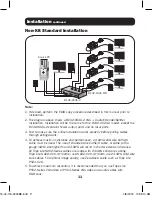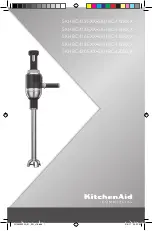
7
Installation
EDID Copy
Compatibility issues can occur when EDID information is not properly
communicated between the source and the display. All of the transmitter
units in this manual include an EDID copy feature which stores a
monitor’s EDID information in the transmitter and sends it to the source,
ensuring optimal compatibility.
The transmitter can only store EDID information copied from a single
monitor. You should copy the EDID information of the monitor that
has the lowest maximum supported resolution of all monitors being
connected. This monitor must also support the native video resolutions of
the other monitors.
For example, if you plan to use three monitors that support the
resolutions listed below, you should copy the EDID information from
Monitor A, since the highest resolution it supports is 1440 x 900, which
is lower than the highest supported resolutions of the other two monitors.
Monitor A’s supported resolutions are also supported by Monitors B and C.
A. 1440 x 900, 1024 x 768, 800 x 600
B. 1920 x 1080, 1680 x 1050, 1600 x 1200, 1024 x 768, 800 x 600
C. 1920 x 1080, 1680 x 1050, 1600 x 1200, 1280 x 768, 1152 x 768,
1024 x 768, 800 x 600
If you are not using the EDID copy feature, the transmitter will use a
default set of EDID information.
Note:
Receiver units will support EDID copy as long as they are used with a
transmitter unit that supports it.
To use the EDID copy feature, follow the instructions below:
1
Determine which monitor to perform EDID copy on, per the example
in the EDID Copy section above.
2
If using a B132-002A-2 or B132-004A-2 model, connect the
powered-on monitor to the input port of the transmitter unit. For the
B130-101A-MR and B130-101A-SR, connect the built-in VGA cable
on the transmitter unit to the powered-on monitor.
15-04-118-9333BE.indd 7
4/8/2015 10:35:10 AM



